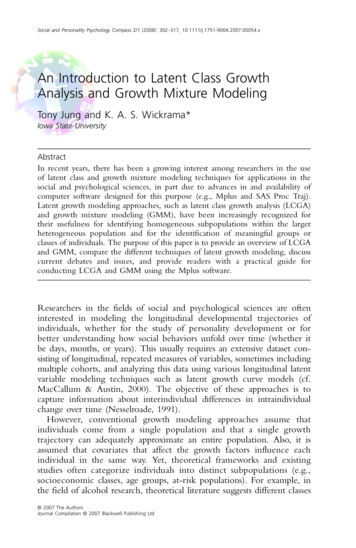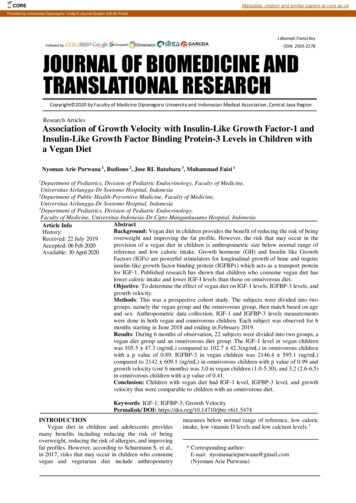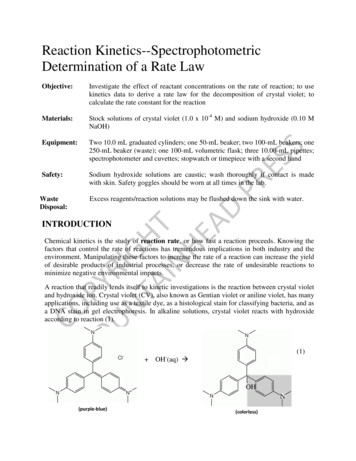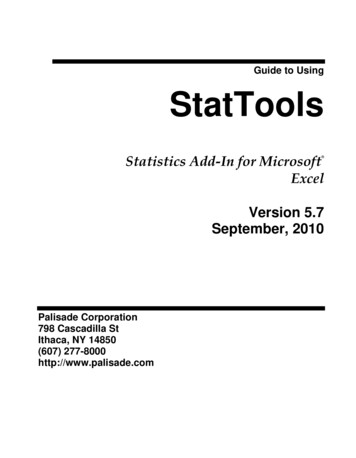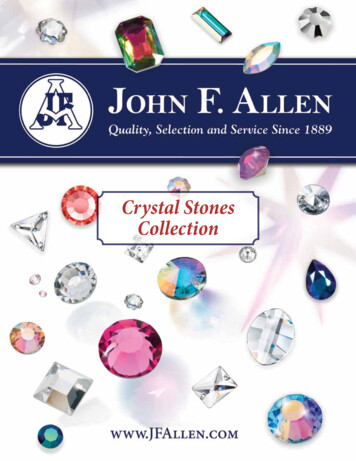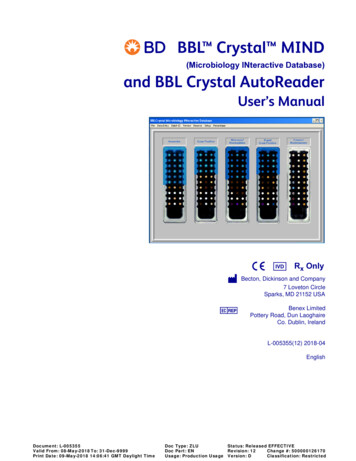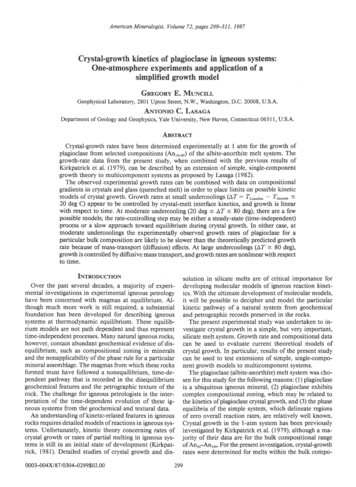
Transcription
American Mineralogist, Volume 72, pages299-31 I, 1987Crystal-growth kinetics of plagioclasein igneoussystems:One-atmosphereexperimentsand application of asimplified growth modelGnnconvE. MuNcrr-r.Geophysicallaboratory, 2801 Upton Street,N.W., Washington, D.C. 20008, U.S.A.ANroNro C. Lnslc.lDepartment of Geology and Geophysics,Yale University, New Haven, Connecticut 065 I I, U.S.A.AssrRAcrCrystal-growth rates have been determined experimentally at I atm for the growth ofplagioclasefrom selectedcompositions (An,o-oo)of the albite-anorthite melt system. Thegrowth-rate data from the present study, when combined with the previous results ofKirkpatrick et al. (1979), can be described by an extension of simple, single-componentgrowth theory to multicomponent systemsas proposedby Lasaga(1982).The observed experimental growth rates can be combined with data on compositionalgradientsin crystals and glass(quenchedmelt) in order to place limits on possiblekineticmodels of crystal Bfowth. Growth rates at small undercoolings(AZ : fi,o-6"" - Zc.o*r,s20 deg C) appear to be controlled by crystal-melt interface kinetics, and growth is linearwith respectto time. At moderate undercooling (20 deg AT 80 deg), there are a fewpossiblemodels; the rate-controlling step may be either a steady-state(time-independent)process or a slow approach toward equilibrium during crystal efowth. In either case, atmoderate undercoolings the experimentally observed growth rates of plagioclase for aparticular bulk composition are likely to be slower than the theoretically predicted growthrate becauseof mass-transport(diffirsion) effects.At large undercoolings(AZ 80 deg),gxowth is controlled by diftrsive mass transport, and growth rates are nonlinear with respectto trme.ItvrnonucrroNsolution in silicate melts are of critical importance forpastOver theseveral decades,a majority of experi- developing molecular models of igneous reaction kinetmental investigations in experimental igneous petrology ics. With the ultimate development of molecular models,have been concerned with magmas at equilibrium. Alit will be possible to decipher and model the particularthough much more work is still required, a substantial kinetic pathway of a natural system from geochemicalfoundation has been developed for describing igneous and petrographicrecords preservedin the rocks.systems at thermodynamic equilibrium. These equilibThe present experimental study was undertaken to inrium models are not path dependentand thus represent vestigatecrystal growth in a simple, but very important,time-independentprocesses.Many natural igneousrocks, silicate melt system.Growh rate and compositional datahowever, contain abundant geochemicalevidenceofdiscan be used to evaluate current theoretical models ofequilibrium, such as compositional zoning in minerals crystal growth. In particular, results of the present studyand the nonapplicability of the phaserule for a particular can be used to test extensionsof simple, singJe-compomineral assemblage.The magmasfrom which theserocks nent growth models to multicomponent systems.formed must have followed a nonequilibrium, time-deThe plagioclase(albite-anorthite)melt systemwas chopendent pathway that is recorded in the disequilibrium senfor this study for the following reasons:(l) plagioclasegeochemicalfeaturesand the petrographic texture oftheis a ubiquitous igneous mineral, (2) plagioclaseexhibitsrock. The challengefor igneous petrologists is the inter- complex compositional zoning, which may be related topretation of the time-dependent evolution of these ig- the kinetics ofplagioclase crystal owth, and (3) the phaseneous systemsfrom the geochemicaland textural data.equilibria of the simple system, which delineate regionsAn understandingofkinetic-related featuresin igneous ofzero overall reaction rates, are relatively well known.rocks requiresdetailed models ofreactions in igneoussys- Crystal growth in the l-atm system has been previouslytems. Unfortunately, kinetic theory concerning rates of investigatedby Kirkpatrick et al. (1979), although a macrystal growth or rates of partial melting in igneous sys- jority of their data are for the bulk compositional rangetems is still in an initial state of development (Kirkpatof Anro-An,*. For the presentinvestigation, crystal-growthrick, 1981). Detailed studies of crystal owth and dis- rates were determined for melts within the bulk compo0003{04xl87/0304{299 02.00299
MUNCILL AND LASAGA: CRYSTAL-GROWTH KINETICS OF PLAGIOCLASE1w
30rMTINCILL AND LASAGA: CRYSTAL-GROWTH KINETICS OF PLAGIOCLASETnele 1. Nominaland analyzedcompositionsof l66.021.32.11 rthiteseeoanalyzed{4C.CeRl19.60.8101.0Cations on the basis of eight oxygensAINaTotal2.901.100.100.905.002.881. 1 .01. Wet-chemicalanalysisf Loss on ignition. Average of 10 spot analyses with an electron-microprobeanalyzelsitional range Anro-An4'. The compositions of plagioclasecrystals that grow from melts within this bulk compositional range are similar to compositions of naturally occurring, complexly zoned plagioclase crystals from a variety ofrock types (Vance, 1962). Thus, proposed kineticmodels for the origins of geochemical features such asoscillatory zoning in plagioclase (Sibley et al., 1976; Haaseet al., 1980; Allegre et al., 1981) can ultimately be tested.ExpnnrllruNTAlpRocEDUREPreparation of starting rnaterialsThe compositions of the anhydrous starting materials correspond to plagioclasecompositions of Anoo,Anro, Anro, and An,o.The startingmaterialswerepreparedas gels(Luth and Ingamells,1965). The gels were dried in an oven at 120.C for 12 h andwere subsequentlyfired in stagesat temperaturesfrom 400 to950"C. The resulting sintered mixtures were ground in an agatemortar and pestle in order to pass through a #200 mesh sieve.The nominal compositions and wet-chemical analysesare presentedin Table l.In order to confine the present study to an investigation ofcrystal growth, it was necessaryto separate the effects of crystalgrowth from the effects of nucleation. A majority of previousexperimental studies have included the added complication ofhomogeneousnucleation, with a resulting lack of accuracy indetermining the time of initiation of crystal growth. The presentinvestigation avoided the "added variable" ofnucleation throughthe use of seedcrystals.Seedcrystals of uniform size (100-250pm) were prepared from crystals of natural, igneous anorthite(Annr) by grinding and sieving. An averageofseveral electronmicroprobe analysesof seedcrystalsis presentedin Table tswere performed at I atm rn a vertical-tube quench furnace. The experimental chargeswere pre-pared by mixing I 50 mg of the appropriate starting compositionwith approximately I mg of seedcrystals.The mix was placedinto a 5-mm-diameter Pt capsulethat had been welded shut atone end. The experimental chargewas suspendednext to a PtPteoRhrothermocouple in the vertical-tube furnace. All chargeswere initially brought to a temperature 30 deg above the appropriate liquidus temperature for a period of 25 min to 2t/zh. Itwas found by trial and error that 30 min was the optimum homogenization time for melting of the Anoobulk composition,becauselonger times resulted in substantial dissolution of theanorthite seedcrystals.Longer homogenizationtimes were usedwith more albite-rich An,o and Anro bulk compositions becausethe seedcrystalsdid not dissolve as readily into thesemore viscousmelts. The formation of compositional gradientsin the meltnext to the seedcrystalsfrom dissolution effectswas checkedby"zero-time" studiesof runs quenchedimmediately after homogenization. There were no detectablecompositional gradients inthe glassessurrounding the seedcrystals.In the first set of experiments, the temperature of each runwas decreasedfrom the homogenization temperatureto the appropriate growth temperatureby adjusting the temperaturecontroller. Owing to thermal inertia of the furnace, it took up toseveral minutes to reach some of the lower run temperatures,and temperature undershooting was a common phenomenon.Kirkpatrick et al. (1979) noted that similar growth rates couldbe obtained from experimentson supercooledmelts and experiments employing reheatedglasses(quenchedmelt). From preliminary runs during the present study, no diferences were observed in results from crystal-growth experiments withmostsupercooledmelts or reheatedquenchedglasses.Therefore,ofthe present l-atm experimentswere conductedwith quenchedglasses.The l-atm crystal-gowth experimentswith quenchedglasseswere carried out by inserting the experirnental charge in the vertical-tube furnace at the appropriate crystal-growth temperature.In all cases,the reading thermocouple approachedthe run temperature within 1.5 to 2 min. Although there may have been a Fig. l. Photomicrographs of plagioclasecrystal morphology. (a) Crossed polars of thin, tabular crystals radiating from ananorthite nucleus.The field of view is 0.8 mm across(long edge).AT: l8 deg, c : Anro. (b) Crossedpolars of crystalswith skeletalmorphology. The field of view is 0.8 mm across.AI : 37 deg,c: Anoo.
302MUNCILL AND LASAGA: CRYSTAL-GROWTH KINETICS OF PLAGIOCLASE
MUNCILLAND LASAGA: CRYSTAL-GROWTH303KINETICS OF PLAGIOCLASEAnloC.--rEEoEooEo(r -.cBo 6 'o-"iloor3ooiloot300TemperoturefC)Fig. 3. Plotsof crystal-gowthratesvs. temperaturefor An,oandAnrobulk compositions.to'r900ilootso1500 90ilooBml50o("C)Temperoturefor AnroFig.4. Plotsof crystal-gowthratesvs. temperatureand Anoobulk compositions.with the experimentalcharge,theslowerrise time associatedtime requiredto reachthermal equilibrium accordingto heatflow calculationsis lessthan 2 to 3 min, which is significantlylessthanthetime requiredto bringrunsfrom superliquidusmelttemperaturesto the growthtemperatures.Eachexperimentwasquenchedin a streamofair. Thecapsulewouldquenchto belowred heatwithin 2 to 4 s. The run productsweremountedinepoxy,anda polishedthin sectionwasproducedfrom theepoxywith the aidblock.The polishedthin sectionswereinvestigatedofan opticalmicroscopeand an electron-microprobeanalyzerin order to determineoptical and chemicalpropertiesof theplagioclasecrystals.experimental variation to this pattern is the anorthitecrystal-growth study of Klein and Uhlmann (1974), inwhich the anorthite was reported to be elongatealong thec axls.At undercoolings of 60 to 80 deg, the crystals formdendrites (seeFig. 2a), with side branchesgrowing fromthe major dendrite arms. The crystallographic directionof primary growth cannot be determined by conoscopicoptical methods, becauseof the small size of the dendrites. The length-fast character of the dendrites precludesthe b crystallographicaxis as the principal growthdirection, but no distinction can be made as to whetherExpnnrnnnnrAl Rx,suLTSthe a or c axis is the predominate elongatecrystallographCrystal morphologiesic axis.For all of the compositions (An,o, Anro, Anro, Anoo),At undercoolingsgreaterthan 80 deg, the crystal formthere was a progressivechangeof crystal morphology withof the plagioclasesurrounding the seedcrystals is spherdegreeofundercooling, as has been noted previously by ulitic or fibrillar (seeFig. 2b). Many of the very fine plaKirkpatrick et al. (1979). At undercoolings of less than gioclaseneedlesdo, however, maintain facetedshapesat40 deg, plagioclase occurs as euhedral, faceted crystals the tips of the crystals.In addition, as noted by Kirkpatthat appear as thin platelets (see Fig. la). The crystals rick (1981) for other systems,the thicknessof the crystalshave an averageaspectratio (a:b:c) of 20:-l:20, as deter- and the spacing between crystals within the bundles ormined by optical methods. Thus, the crystalsare tabular, spherulesdecreasewith increasedundercooling.When observed optically under crossed polars, thewith the largest growth face (in area) being representedby the {010} face. This observation is in general agree- crystalsappearto be unzoned,becausethere is no changement with the predominant morphology of natural pla- in extinction angle within the individual crystals. Manygioclasecrystals(Heinrich, 1965; Deer et al., 1966),al- of the individual crystals also contain growth twins; thisthough natural crystals have sigrrificantly smaller aspect phenomenonwas observedprimarily in crystalsthat grewat uncercoolingsofless than 60 deg.ratios than those of the synthetic crystals.At undercoolingsof 40 to 60 deg, the resulting crystalsare skeletal;this morphology is even the casefor the crys- Growth ratesThe crystal-growth data have been plotted versustemtal overgrowths around the anorthite seed crystals (seeFig. lb). The averageaib:c aspectratio of these crystals perature, a common method for presentation of growthis approximately25:1:5. The a axis is the direction of data (Kirkpatrick, l98l), for each of the compositionsprincipal growth, which has been observedin other feld- (Figs. 3 and 4). The "best fit" lines were hand-fil to thespar-crystallizationstudies (Fenn, 1977; Swanson, 1977) maxima of the growth data for each growth temperatureand is common in nature (Deer et al., 1966). the only that was investigated. One reason for the scatter in thetsFig. 2. Photomicrographsof plagioclasecrystal morphology. (a) Crossedpolars of dendritic crystals.The field of view is 0.32mm across.Af : 60 deg, c : An*. (b) Spherulitic morphology of crystals around a seedcrystal as viewed through crossedpolars.The field of view is 0.8 mm across.AZ : 123 deg,c : Anoo.
304MLINCILL AND LASAGA: CRYSTAL-GROWTH KINETICS OF PLAGIOCLASEAn40aT 250g!o ooIooItE200:ona
simplified growth model Gnnconv E. MuNcrr-r. Geophysical laboratory, 2801 Upton Street, N.W., Washington, D.C. 20008, U.S.A. ANroNro C. Lnslc.l Department of Geology and Geophysics, Yale University, New Haven, Connecticut 065 I I, U.S.A. AssrRAcr Crystal-growth rates have been determined experimentally at I atm for the growth of plagioclase from selected compositions (An,o-oo) of the albite .
